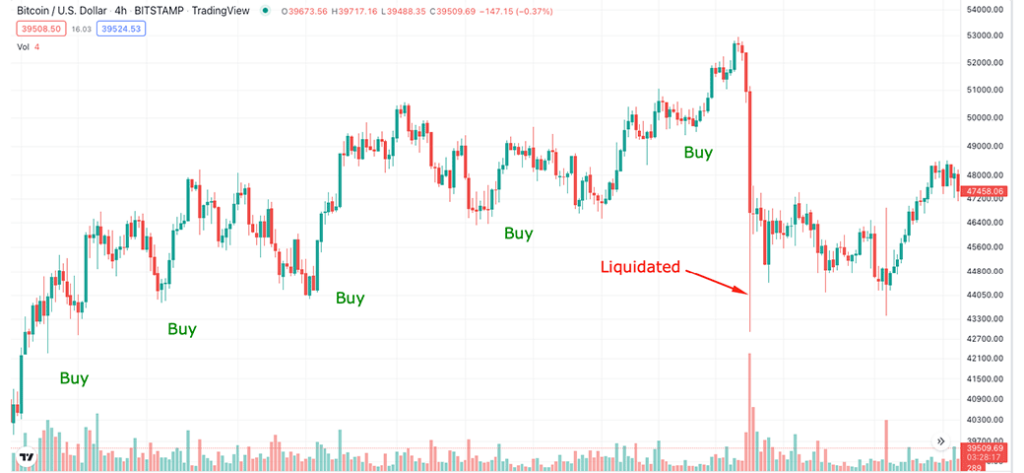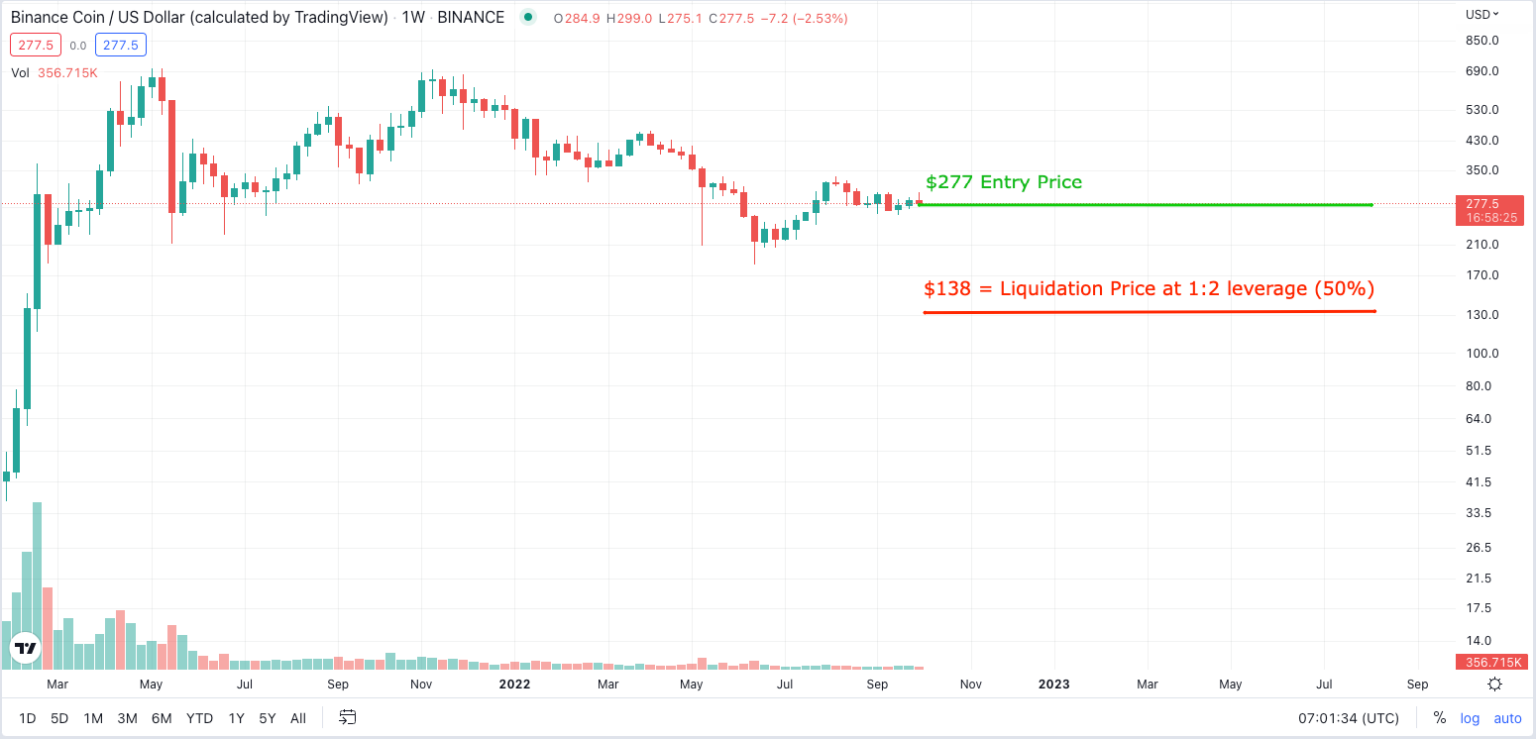You’ve probably heard the term liquidation when it comes to trading with leverage, but what does it really mean, and how can we avoid getting liquidated while trading the financial markets?
If you have been a victim of liquidation or if you just want to educate yourself to protect your account, keep reading.
Getting liquidated happens in the same way but there is a difference between the risks in forex vs crypto vs stocks where crypto is actually the less risky market to trade.
Key takeaways
- Liquidation in leverage trading occurs when your leveraged position loses too much capital and your margin can no longer support the losses. This results in the closure of all positions and the loss of all funds in your account.
- Higher leverage ratios increase the risk of liquidation. Analyze the average volatility of your asset class and choose a leverage ratio accordingly.
- The article provides two examples of liquidation scenarios—a panic sell-off with a large position and a short position that goes out of control. These examples illustrate the importance of risk management and using stop losses to prevent liquidation.
Related: Liquidation price calculator
If you are worried about getting liquidated, feel free to use our guide on high leverage trading strategies to improve your risk management skills.
Liquidation in margin trading is what happens when your position has lost too much capital and your margin can’t support the overall losses of your account.
When you get liquidated, all your positions are closed out, and all your funds are lost.
This is probably the worst-case scenario for any investor and today we are going to break down exactly what liquidation is and how we can avoid it in the future.
When it comes to trade management, controlling your risk of liquidation is a priority, even when you are planning your trade.
To find out more about how margin positions work, see this guide:
You will learn
What is liquidation in leverage trading?
Liquidation is a complete loss of all capital in your live trading account due to losses that could not be supported by your margin capital.
When you run out of funds in your leveraged account you will get a margin call telling you that you are almost out of support for your open position.
If you don’t close out the position or add more funds to your account after getting the margin call and the market keeps going against you, you will suffer losses that are bigger than your overall account size, and all your positions will get closed out and liquidated.
After a liquidation, your account balance is set to 0 which means that all your deposited funds have been lost.
It’s sad but true, it happens very frequently among novice traders who take on too much risk while trading the financial markets.
You can get liquidated when trading any asset class and as long as your position has a ratio of at least 1:2 there is a chance to get liquidated.
When trading without leverage, you cannot get liquidated since there are no borrowed funds connected to your open position.
A non-leveraged position can only go to near zero value but no matter how big the losses are it can never liquidate your open position.
Can you go negative with leverage?
Yes, it is possible to lose more than you invest, but only if your broker doesn’t support negative balance protection.
Liquidation can also happen in leverage-traded long-term investing when the investor chooses a ratio that is too high.
Forex trading on leverage is also an arena where traders are constantly liquidated due to overleveraged positions with a low margin requirement.
Why does it happen?
Liquidation happens when your current account balance can’t support your open losses in your trading account.
The calculation for this is pretty straightforward and can be explained with a simple example.
Let’s say that you have a trading account of $1000 and you open a position with all this money.
Your $1000 position will go up and down with the market and it can even lose as much as 99% of its value but it can never be liquidated.
Now, if we add a leverage ratio of 1:2 to this mix and open a maximum position size with your $1000 account your new maximum position size will be $2000.
Remember that you only deposited $1000 in your account so your margin capital will only be able to handle a loss of $1000. If the position loses as much as $1001 you will get liquidated.
In this example, we don’t take into consideration commissions for opening the position. But this is the general idea of what liquidation means.
How can you avoid getting liquidated
There are a couple of ways to avoid liquidation completely and I will give you some general advice on how to stay safe without running the risk of losing your whole account.
In 90% of liquidation cases, it’s a beginner mistake that caused the loss of all funds, and if you know the basics of risk management when trading with leverage you will stay safe.
Below is a list of the best ways to avoid liquidation in trading:
- Use a low leverage ratio – Your ratio is what decides your risk factor. A higher ratio will reduce your liquidation price and increase the risk of getting liquidated. With a high ratio, you have less room to play with when the market is fluctuating. A great tip is to analyze the average volatility of your asset class and choose your ratio according to that metric. This will keep you away from danger.
- Calculate your margin requirement – One of the most important aspects of trading any asset class with credit is to be able to calculate your leverage and your margin requirement for each position. If you know how much margin you put into each position then it’s less likely that you will liquidate your account.
- Use a stop loss – It’s nearly impossible to get liquidated when using a stop-loss order. On some rare occasions, your stop-loss level will not get hit and you take a significant loss but this is highly unlikely. In 99.9999% of the cases, your stop loss will determine your risk level and it should always be used when entering the market.
- Trade only one market – If you are a beginner trader I would recommend only trading on the market at the time to avoid confusion between your positions. It’s easier than you think to lose control over one or more positions if you have an account full of open positions in several markets. Focus on one market and do it well!
- Always use isolated margin – This is a big one. To avoid liquidating your whole account in any single trade I would recommend always using an isolated margin. Isolated margin means that you isolate the margin capital you used for one position only. This margin can not be used for other open positions and it will also disable your account from using more margin if one position goes heads south. The difference between cross margin vs isolated margin is whether the margin is shared or or contained between positions.
- Avoid markets that gap up or down – It’s much more likely to lose your money if you trade an underlying asset that is closed during the weekends and opens with a gap up or gaps down on Monday morning. This way you can’t control your risk at all and you can only pray that the market is nice to you. Don’t leave your trades open over the weekend.
Some examples
If you have ever been liquidated I can only assume that it was a horrible experience that followed after a couple of bad losses and one final big loss that wiped out your entire stake. In this section, we are going to look at two different examples that can cause a liquidation in your trading account. The first example is a panic sell-off with a large position and the second example is a short position that gets out of control.
Example 1

This is a typical scenario where a beginner is day trading with leverage and the market keeps climbing higher during the day and the trader adds to the position in every dip.
Once the market gets overheated a large profit-taking sell-off initiates a panic sell-off that triggers a wave of liquidated positions. This could easily be avoided with the use of a stop-loss order or using a lower ratio.
This type of liquidation usually happens very fast and the trader doesn’t see it coming before it’s too late.
This was a drop of about 15%-20% and if you were to use a leverage ratio of more than 1:5 you could not handle this situation without adding more margin capital or closing out your position with a large loss.
Example 2

Here is another common scenario where a trader thinks he or she has got a short position under control when in reality things could not be further from the truth. This happens a lot when novice traders try to short sell a market that is just doing a pullback before resuming the ongoing uptrend.
The market breaks down, indicating a negative sentiment, and the second break is the entry point for our beginner trader. He or she opens the short position at the lows and follows the market for a few days until the underlying positive trends come back to life and push the short position into a liquidation.
These kinds of swing trades are very dangerous because things can start off well and it gives you a false sense of security. What you should do in this case is to always use a stop loss to prevent liquidation. Short-selling is very difficult and should only be attempted at very low leverage ratios.
Related: Can you short-sell without leverage?
How to determine your risk
To know your liquidation risk or liquidation price you can make a simple calculation to determine how much room your position has to move before getting liquidated. For example, if you use a 1:2 ratio, you have a 50% liquidation price. If you were to use a 1:3 leverage ratio, your liquidation price would shrink to 33%, and so on. Below is a table showing you the most common margin ratios and their liquidation risks/prices.
| Leverage ratio | 1:2 | 1:5 | 1:10 | 1:25 | 1:50 | 1:100 | |
| Liquidation risk/price | 50% | 20% | 10% | 4% | 2% | 1% |
As you can see, the more borrowed capital you add to a position, the closer your liquidation price gets, and the higher your risk becomes. Use this table to calculate your own risk of liquidation when using margin.
What other traders ask
When you get liquidated all your positions are closed out in a maximum loss and all your funds are lost.
Yes, it negatively affects the liquidation price. The more credit you add the closer your liquidation price gets. A leverage ratio of 1:100 will be riskier to trade.
Yes, when you increase your credit you take on significantly more risk and you stand a much higher chance of getting liquidated.
This depends if the broker has a negative balance protection policy. Without negative balance protection, you can owe your broker money when getting liquidated.
1. Always use a stop loss.
2. Calculate your margin capital for each position.
3. Use a low leverage ratio.
4. Focus on one market only.
5. Always use an isolated margin.
No, it will not. The margin call is a warning sign that you are close to getting liquidated.
Wrapping up
Liquidation is the worst-case scenario for any trader using margin and in this guide, I explain how liquidation happens, how it works, and also how to avoid it. I recommend that you start slowly and increase your borrowed capital only when you feel comfortable.
Since the risks of leverage products are much higher I recommend applying treading carefully in the beginning since these products can be extremely risky, especially if you are a beginner.
You need to protect your downside risk at all costs. However, should you fall victim to total liquidation, start over by first analyzing your mistakes.
Other helpful resources:

